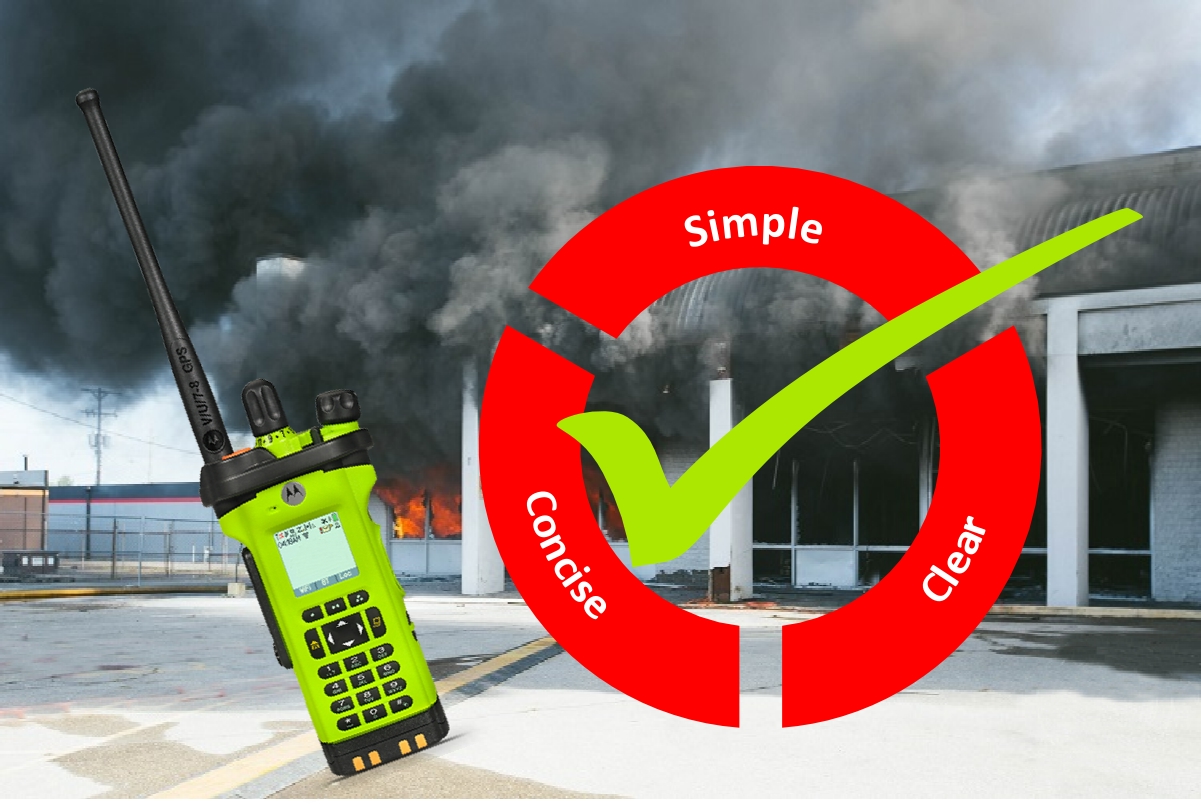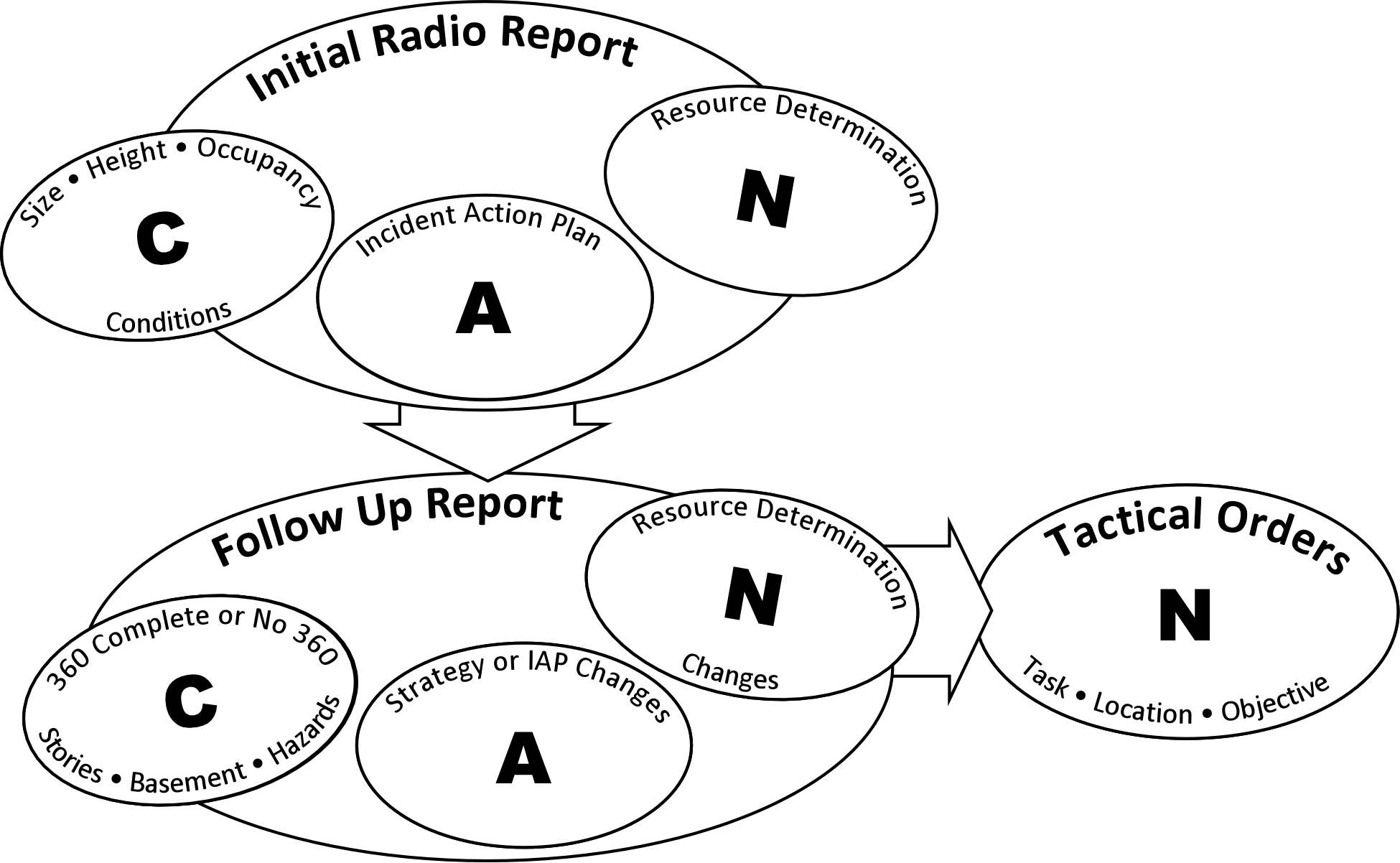Simple, clear, & concise fireground communications.

2nd Law of Combat
In their book Extreme Ownership, retired Navy Seals Joko Willink and Leif Babin state that the 2nd law of combat is to “keep communications simple, clear, and concise”. This is as essential on the fireground as it is in military combat! Blue Card provides a solid framework for simple, clear, and concise fireground communications. From the incident radio report to critical mayday radio traffic, the sequence and content of communication is well defined.
Situational Awareness
On the fireground, situational awareness is perceiving and understanding the problems and conditions presented by an incident. ICs gather information through observation and communication on an ongoing basis. We always have situational awareness, but in some cases our awareness does not match reality (and reality always wins).
Communication of conditions, actions and needs between the IC and operating companies is a key component of accurate situational awareness.
Conditions, Actions, and Needs (CAN)
If you stop and think about it, most fireground communications are connected to conditions, actions and/or needs. This begins with IC #1s initial radio report and follow up report.

As the incident progresses CAN reports provide the IC with essential information that in most cases cannot be directly observed by the IC. This flow of information is essential to the ICs situational awareness and providing a common operating picture for resources operating at the incident.
Transfer of conditions, actions, and needs information also occurs in each of the following radio communications:
- Transfer of command.
- IC driven CAN report.
- Roof report.
- Status change.
- Priority traffic.
- Mayday
- Emergency traffic.
The Order Model
For communications to occur, the receiver must hear and understand the message being sent. The order model ensures that the intended receiver is ready to listen to the message, that the message is transmitted, and the receiver provides feedback that they have heard and understood.
Blue Card includes the type of communication when clearing the receiver to improve the ability of ICs, tactical supervisors, and dispatchers to prioritize and process key information. For example:
- Dispatch, Engine 1 with an initial radio report.
- Command, Ladder 1 with a roof report (or priority traffic if it is bad news).
- Division Alpha, Engine 2 with a status change.
- Command, Engine 1 with priority traffic.
The only communication that does not follow the order model is a mayday message. With a mayday message, the sender transmits MAYDAY, MAYDAY, MAYDAY, and identifies who, what, where, and needs (the mayday CAN).
Information Density
Information density is the amount of relevant information in a text or spoken message. Messages with high information density convey critical information with the fewest words and in the shortest timeframe. Achieving high information density in incident communications involves prioritizing clarity, being concise, and eliminating unnecessary words of filler that don’t contribute to information contained in the message. High information density can make communication more efficient and effective, particularly when communicating under time pressure.
Written communication can be edited to improve information density. This can be time consuming. As Mark Twain once said, “I didn’t have time to write a short letter, so I wrote a long one”. Oral communication presents a greater challenge as there is no opportunity to edit your message once it is spoken. Improving the information density of incident communications requires focused effort and deliberate practice. Filler words (such as “at this time” and “when you arrive” and rambling, unfocused messages are enemies of effective information dense communications.
The initial radio report is a great place to start work on improving information density. Engine 1 clears dispatch for an initial radio report (IRR) and receives acknowledgement from the dispatcher. Compare and contrast the following two example of the initial radio report from Engine 1:
- Engine 1 is on-scene of a small, one-story single-family residential structure, with a working fire, fire showing from Side Alpha, Engine 1 is stretching a 1-3/4” preconnected hoseline through Side Alpha for fire control and primary search, upgrade to a full first alarm, Engine 1 is Main Street Command. (45 Words)
- On-scene of a small, one-story house, with a working fire on Side Alpha, Engine 1 is stretching an attack line through Side Alpha for fire control and primary search, upgrade to a first alarm, establishing Main Command. (37 Words)
The second IRR example conveys the same critical information as the first, but with an 18% reduction in word count. Keys to this reduction were using one word rather than two or three to covey the same information and eliminating any words that do not add value.
Push to Talk-Not Push to Think
Before pushing the microphone button to transmit a message on the fireground, know what you are going to say. Talking on the radio while you think about the information that needs to be communicated results in rambling radio transmission and use of filler words while the brain processes what to say next.
Blue Card provides a standard format for most fireground communications that is simple and uses common descriptors for many standard conditions. Ongoing practice and feedback on your communications skills will provide a solid basis for continuous improvement. Feedback on conciseness and clarity of communications should be a key element in your Blue Card continuing education (CE) and after-action reviews.
Command Presence
In addition to clear and concise messages, effective communication requires the sender to remain calm and communicate with confidence. This is the essence of command presence in radio communication. Over a decade ago the first arriving engine at an apartment fire in a major metropolitan area encountered a working fire with multiple occupants trapped and others who had jumped to escape the fire. The initial radio report was Engine 82 on-scene, holy s__t. While this initial radio report conveyed the engine officer’s emotional response, it didn’t convey critical information to responding companies and command officers.
As IC #1 or IC #2, the way that you present in your radio communications will have a major impact. If you are calm and communicate clearly and concisely, you will inspire confidence. Before you push the transmit button, take a breath, exhale deliberately and make sure that you know what you are going to say and how you will say it.
Action Steps to Improve Communications Skills
- Engage in deliberate practice. Use the standard Blue Card message formats and make a conscious effort to improve your communications (same information types in the same order every time).
- Listen to yourself (audio recording of incident radio traffic or record your communications practice).
- Write it down (practice maximizing information density by writing down your standard communications and eliminating filler and editing for clarity. Read the revised message aloud.